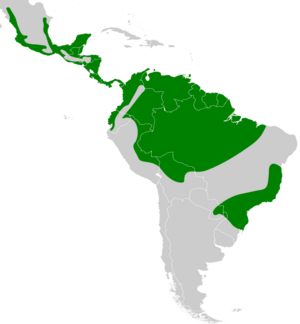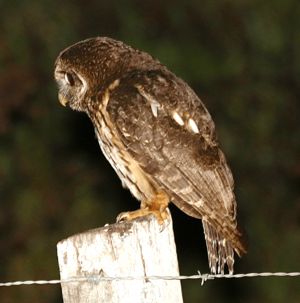Mottled owl facts for kids
Quick facts for kids Mottled owl |
|
|---|---|
 |
|
| Conservation status | |
| Scientific classification | |
| Genus: |
Strix
|
| Species: |
virgata
|
 |
|
| Synonyms | |
|
Ciccaba virgata |
|
The mottled owl (Strix virgata) is a cool, medium-sized owl. You can find it in Central and South America. Its home stretches all the way from Mexico down to Brazil and Argentina.
This owl has a brown head and back with a mottled, or spotted, pattern. Its belly is whitish with vertical stripes on its chest and throat. Mottled owls have dark eyes and a round head. They do not have the ear tufts that some other owls have. These owls are very protective of their homes. They live in dry forests and jungles. You can find them in places up to about 8,200 feet (2,500 meters) above sea level.
Contents
What Is a Mottled Owl?
The mottled owl is a type of owl that belongs to the Strix group. This group includes many owls that do not have ear tufts. An American bird expert named John Cassin first described this owl in 1849. He gave it the scientific name Syrnium virgatum. Later, in 1999, some scientists moved it to the Strix group. But some other experts still debate this change.
How to Spot a Mottled Owl
The mottled owl is a medium-sized bird. Adult owls are usually about 11 to 14 inches (280 to 355 millimeters) long. Female owls are quite a bit bigger than males. In fact, female mottled owls show the biggest size difference from males compared to any other owl species!
Their head, neck, and back are covered in dark brown spots and patterns. The feathers around their face are light brown. Their throat, chest, and belly are off-white with clear vertical brown stripes. They have large, brown eyes. Their beak can be grayish-yellow or grayish-blue. Their legs and feet are also grayish-yellow.
Some mottled owls are darker overall. These birds have a buff-colored chest and belly. Mottled owls make many different sounds. These include a hoot they use to mark their territory. They also make whistles, screeches, and hissing sounds.
Where Mottled Owls Live
The mottled owl lives in Central and South America. Its range goes from Mexico all the way south to Argentina and Brazil. These owls can be found in places up to about 8,200 feet (2,500 meters) high.
They live in many different types of wooded areas. This includes rainforests, edges of woodlands, dry thorn forests, and pine and oak forests. They also live in tree plantations and open areas with scattered trees. In some places, they are quite common. You might even find them living close to towns and cities.
In 1983, a mottled owl was found in the United States, near the Rio Grande. This was the first time one was seen there. Later, in 2006 and 2023, more mottled owls were seen and photographed in Texas.
Mottled Owl Behavior and Life Cycle
Mottled owls are nocturnal animals. This means they are active at night. During the day, they hide in thick plants and trees. Other birds might even try to bother them while they are resting. Their big eyes help them see well in low light. They also have very good hearing.
These owls are hunters. At night, they often sit on a tree branch. They watch for prey in clearings or at the edge of the forest. When they see something small moving, they silently swoop down. They pounce on their target with their strong talons.
Mottled owls eat small mammals, birds, reptiles, and amphibians. They also eat large beetles, grasshoppers, and other insects. They are even known to hunt bats!
Mottled owls lay their eggs between February and May in Colombia. In Argentina, they breed from September to November. They usually make their nests in a hole in a tree. Sometimes, they might use an old nest built by another bird. The female owl usually lays one or two white eggs. She sits on the eggs to keep them warm. Both parent owls help take care of the young owlets.
Mottled Owl Status
The mottled owl lives in a very large area. Scientists believe there are between 500,000 and 5 million of these owls. The IUCN (International Union for Conservation of Nature) lists the mottled owl as "Least Concern". This means they are not currently in danger of disappearing. Even though their numbers might be going down a little, it's not fast enough to put them in a more serious category.



